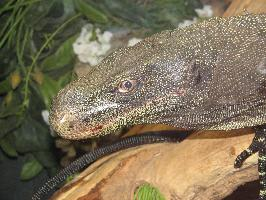
Súlyok és méretek
| Hossz | 75-tól 100-ig cm |
|---|
Veszélyeztetettség
| Veszélyeztetett |
Állatleírás
The Emerald Tree Monitor, scientifically known as Varanus prasinus, is a strikingly beautiful and elusive species of monitor lizard native to the lush rainforests of New Guinea and various islands in the Torres Strait. This arboreal reptile is celebrated for its vibrant green coloration, which serves as an excellent camouflage amidst the verdant foliage of its habitat, allowing it to blend seamlessly with the surrounding environment.Adult Emerald Tree Monitors typically reach lengths of about 75 to 100 centimeters (approximately 30 to 40 inches), with their slender, agile bodies supported by strong, clawed limbs that are adept at climbing. Their tails are prehensile and almost twice the length of their bodies, providing balance and support as they navigate the complex canopy. This tail is a critical adaptation for an arboreal lifestyle, enabling the monitor to grasp branches as it moves through the trees.
The diet of the Emerald Tree Monitor is as varied as the ecosystem it inhabits, consisting of insects, smaller lizards, frogs, bird eggs, and occasionally small mammals. Its mode of hunting is both opportunistic and stealthy, relying on its camouflage and swift movements to ambush prey.
One of the most fascinating aspects of the Emerald Tree Monitor is its vibrant green skin, which not only provides camouflage but also serves as a status indicator among individuals. The intensity of the coloration can signify the health and vitality of the lizard, playing a role in mating displays and territorial disputes. The skin may also feature spots or bands of varying shades of green, blue, or black, adding to the animal's striking appearance.
Breeding for the Emerald Tree Monitor involves the female laying clumps of eggs in tree hollows or burrows, which she then leaves to incubate naturally. The young, when they hatch, are independent and receive no parental care. These juveniles are born with a more muted coloration, which brightens as they mature.
Despite their beauty and fascinating behavior, Emerald Tree Monitors face threats from habitat destruction and the illegal pet trade. Their habitats are being diminished by deforestation, mining, and agriculture, putting pressure on their populations. Additionally, their striking appearance makes them a target for poachers seeking to sell them in the exotic pet market.
Conservation efforts for the Emerald Tree Monitor are crucial to ensure their survival. Protecting their natural habitats, enforcing laws against illegal wildlife trade, and promoting captive breeding programs are essential strategies. Some progress has been made, with the species being listed on CITES Appendix II, which regulates international trade to ensure it does not threaten their survival.
In conclusion, the Emerald Tree Monitor is a remarkable example of the diversity and complexity of tropical ecosystems. Its adaptability, striking coloration, and ecological role underscore the importance of preserving the rich biodiversity of rainforests. As efforts continue to protect this vibrant species, it stands as a symbol of the beauty and fragility of our natural world.
Hasonló állatok
Új állatfotók
Top 10 állat
- Dolphin gull (Leucophaeus scoresbii)
- Diana monkey (Cercopithecus diana)
- Moustached guenon (Cercopithecus cephus)
- Galápagos tortoise (Geochelone nigra complex)
- Japanese macaque (Macaca fuscata)
- Russian tortoise (Testudo horsfieldii)
- Stone loach (Barbatula barbatula)
- Greek tortoise (Testudo graeca)
- Common flying dragon (Draco volans)
- Vendace (Coregonus albula)


